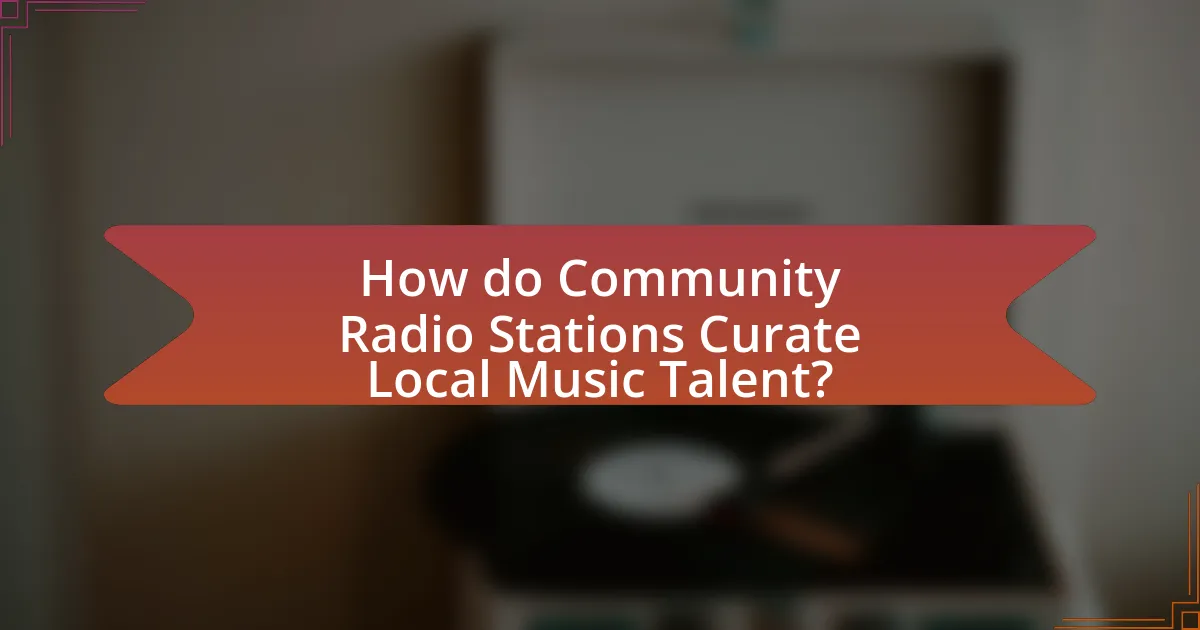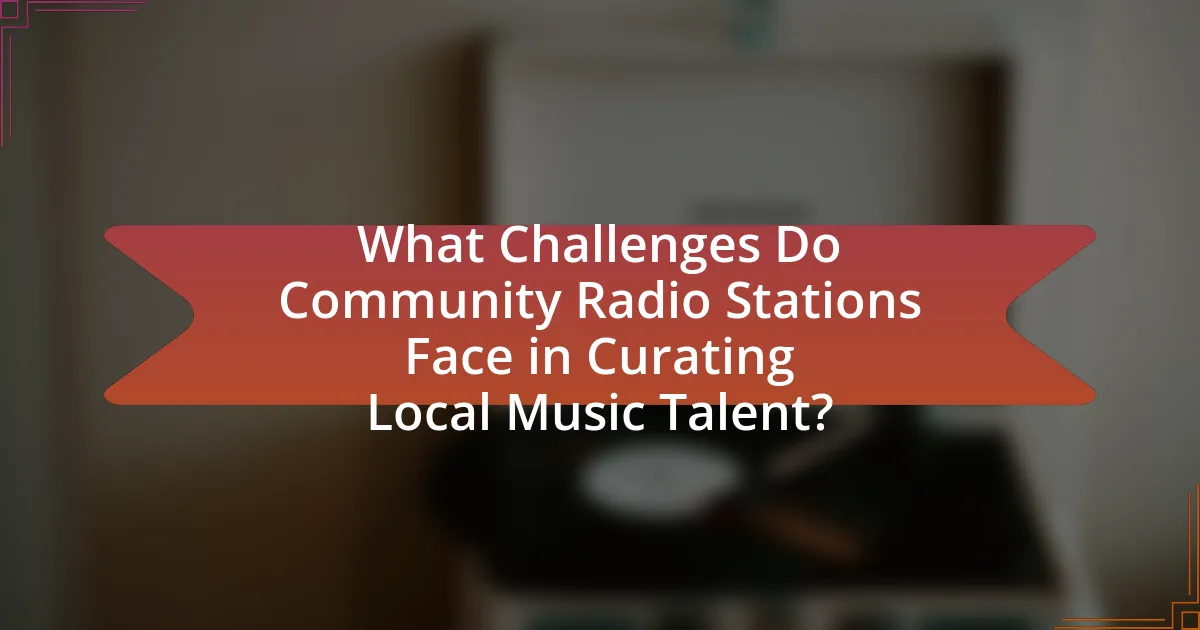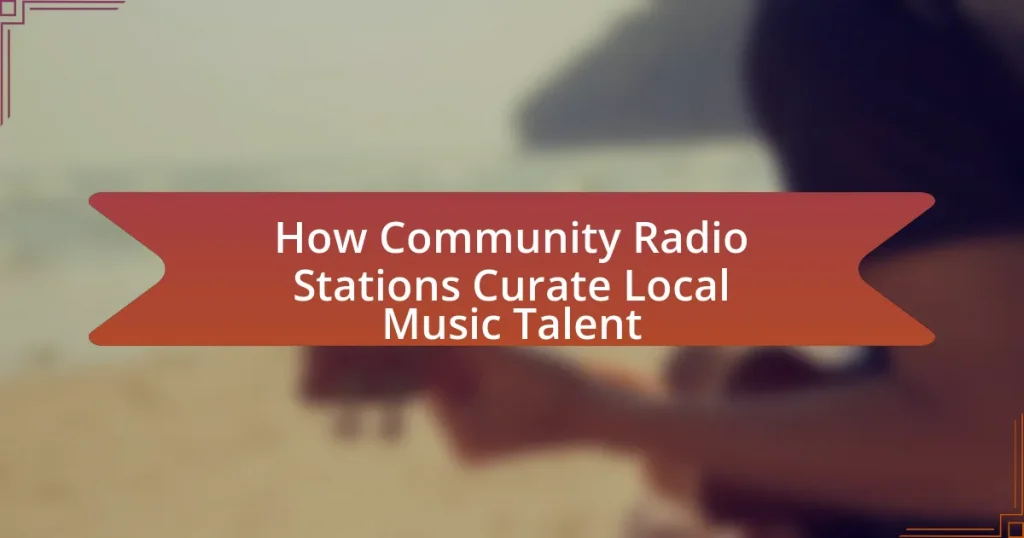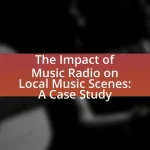Community radio stations are non-profit broadcasting services that play a crucial role in curating local music talent and fostering community engagement. They differ from commercial radio by prioritizing local artists and cultural diversity over profit, often featuring original music, live performances, and artist interviews. The article explores how these stations discover and promote local musicians through outreach initiatives, listener submissions, and collaborations with local events, while also addressing the challenges they face, such as limited funding and competition from larger media outlets. Additionally, it highlights the impact of local music on community identity and cohesion, emphasizing the importance of supporting regional talent in enriching the cultural landscape.

What are Community Radio Stations and Their Role in Music?
Community radio stations are non-profit broadcasting services that primarily serve local communities, providing a platform for diverse voices and music. Their role in music includes promoting local artists, showcasing regional genres, and fostering community engagement through music-related programming. For instance, according to the National Federation of Community Broadcasters, community radio stations often feature local musicians and genres that may not receive attention from commercial radio, thus enriching the local music scene and supporting cultural diversity.
How do community radio stations differ from commercial radio stations?
Community radio stations differ from commercial radio stations primarily in their funding and operational goals. Community radio is typically funded through listener donations, grants, and community support, focusing on serving local interests and promoting local culture, while commercial radio relies on advertising revenue and aims to maximize profit by targeting broader audiences. This distinction allows community radio to prioritize diverse programming, including local music talent, over commercial viability, which often leads to a more homogenized playlist in commercial stations. According to the National Federation of Community Broadcasters, community radio stations provide a platform for underrepresented voices and local artists, fostering a unique cultural landscape that commercial stations often overlook.
What unique features do community radio stations offer to local musicians?
Community radio stations provide local musicians with unique features such as dedicated airtime for original music, opportunities for live performances, and community engagement initiatives. These stations often prioritize local content, allowing musicians to reach their audience directly and gain exposure that commercial radio may not offer. For instance, many community radio stations host music showcases or open mic events, fostering a supportive environment for artists to perform and connect with listeners. Additionally, these stations frequently collaborate with local music festivals and events, further promoting local talent and enhancing community ties.
How do community radio stations foster a sense of community through music?
Community radio stations foster a sense of community through music by providing a platform for local artists and engaging listeners in shared cultural experiences. These stations often feature music that reflects the local culture, allowing residents to connect with their community’s identity. For instance, community radio can showcase local musicians, promote regional genres, and host live performances, which strengthens community ties. Research indicates that community radio enhances social cohesion by encouraging participation and collaboration among listeners and artists, thereby reinforcing a collective identity.
Why is local music talent important to community radio stations?
Local music talent is important to community radio stations because it fosters a sense of identity and connection within the community. By showcasing local artists, these stations promote cultural diversity and provide a platform for voices that may otherwise go unheard. This engagement not only strengthens community ties but also encourages local economic growth through support for local musicians and related businesses. Research indicates that community radio stations significantly contribute to local music scenes, enhancing visibility and opportunities for artists, which in turn enriches the cultural fabric of the area.
What impact does showcasing local talent have on the community?
Showcasing local talent significantly enhances community cohesion and pride. When local artists are featured, it fosters a sense of belonging and identity among residents, as they see their own culture and experiences reflected in the music. Research indicates that communities with active local music scenes experience increased social interaction and collaboration, leading to stronger community ties. For instance, a study by the National Endowment for the Arts found that local arts initiatives can boost community engagement and economic development, demonstrating the tangible benefits of promoting local talent.
How does local music contribute to the identity of a community?
Local music significantly contributes to the identity of a community by reflecting its cultural heritage, values, and social dynamics. This musical expression often incorporates local dialects, themes, and stories that resonate with the community’s experiences, fostering a sense of belonging and pride among residents. For instance, studies have shown that communities with vibrant local music scenes, such as those in New Orleans or Nashville, often see enhanced social cohesion and cultural tourism, which further solidifies their unique identities. Additionally, local music events and festivals serve as platforms for community engagement, allowing residents to connect and celebrate their shared identity through collective participation in musical traditions.

How do Community Radio Stations Curate Local Music Talent?
Community radio stations curate local music talent by actively engaging with their communities to discover and promote emerging artists. They often host open calls for submissions, allowing local musicians to submit their work for airplay, which helps identify diverse talent. Additionally, these stations frequently collaborate with local music events, festivals, and venues, providing platforms for artists to perform live and gain exposure. Research indicates that community radio stations play a crucial role in supporting local music scenes, as they often prioritize local content over mainstream music, thereby fostering a sense of community and cultural identity.
What processes do community radio stations use to discover local talent?
Community radio stations discover local talent through a combination of outreach initiatives, talent showcases, and community engagement. These stations often host open mic events and talent competitions, allowing local artists to perform and gain exposure. Additionally, they collaborate with local music venues and organizations to identify emerging artists. Surveys and social media platforms are also utilized to gather recommendations from listeners, ensuring a diverse representation of talent. This multi-faceted approach not only helps in identifying local musicians but also fosters a sense of community involvement and support for the arts.
How do community events and outreach programs aid in talent discovery?
Community events and outreach programs significantly aid in talent discovery by providing platforms for local artists to showcase their skills and connect with audiences. These events create opportunities for musicians to perform live, receive immediate feedback, and gain exposure to industry professionals, which can lead to further opportunities. For instance, a study by the National Endowment for the Arts found that community arts programs increase visibility for local talent, fostering a supportive environment that encourages artistic growth and collaboration. This direct engagement not only helps artists refine their craft but also allows community members to discover and support emerging talent, thereby enriching the local music scene.
What role do listener submissions play in curating local music?
Listener submissions play a crucial role in curating local music by providing community radio stations with direct insights into the preferences and talents of local artists. These submissions allow stations to discover emerging musicians who may not have mainstream exposure, thus enriching their playlists with diverse sounds that reflect the local culture. For instance, community radio stations often rely on listener feedback and submissions to gauge which artists resonate with their audience, ensuring that the music they promote is relevant and representative of the community’s tastes. This participatory approach not only fosters a sense of ownership among listeners but also strengthens the local music scene by giving artists a platform to reach wider audiences.
How do community radio stations support and promote local artists?
Community radio stations support and promote local artists by providing a platform for their music and facilitating community engagement. These stations often feature local artists in their programming, including interviews, live performances, and airplay of their recordings, which helps to increase visibility and reach for these musicians. According to a study by the National Federation of Community Broadcasters, 70% of community radio stations prioritize local content, showcasing the commitment to supporting regional talent. Additionally, community radio often collaborates with local events and festivals, further amplifying the presence of local artists in the community.
What types of programming are dedicated to local music talent?
Community radio stations dedicate several types of programming to local music talent, including live performance showcases, artist interviews, and genre-specific music hours. Live performance showcases allow local musicians to perform on-air, providing exposure and fostering community engagement. Artist interviews offer insights into the musicians’ creative processes and backgrounds, enhancing listener connection. Genre-specific music hours focus on particular styles, promoting local artists within those genres and creating a platform for diverse musical expressions. These programming types not only support local talent but also enrich the community’s cultural landscape.
How do community radio stations collaborate with local venues and festivals?
Community radio stations collaborate with local venues and festivals by promoting events, broadcasting live performances, and providing platforms for local artists. This collaboration enhances community engagement and supports local music scenes. For instance, many community radio stations partner with festivals to offer live coverage, interviews with performers, and behind-the-scenes content, which increases visibility for both the artists and the events. Additionally, these stations often host their own events in collaboration with local venues, creating opportunities for local talent to gain exposure and connect with audiences. This symbiotic relationship fosters a vibrant local music ecosystem, benefiting both the radio stations and the venues.

What Challenges Do Community Radio Stations Face in Curating Local Music Talent?
Community radio stations face several challenges in curating local music talent, primarily including limited funding, lack of resources, and competition from larger media outlets. Limited funding restricts their ability to promote local artists effectively, as many rely on donations and grants that may not cover extensive marketing efforts. Additionally, a lack of resources, such as access to professional recording equipment and skilled personnel, hampers their ability to produce high-quality content that showcases local talent. Furthermore, competition from larger media outlets, which often have more substantial budgets and wider reach, makes it difficult for community radio stations to attract listeners and support for local musicians. These factors collectively hinder the ability of community radio stations to fulfill their mission of promoting local music talent.
What are the financial and resource limitations of community radio stations?
Community radio stations face significant financial and resource limitations primarily due to their reliance on limited funding sources. Many community radio stations operate on tight budgets, often funded through listener donations, grants, and sponsorships, which can be inconsistent and insufficient to cover operational costs. For instance, a report by the National Federation of Community Broadcasters indicates that nearly 70% of community radio stations report challenges in securing adequate funding, impacting their ability to invest in equipment, staff, and programming. Additionally, resource limitations include a lack of access to advanced broadcasting technology and training, which hinders their capacity to produce high-quality content and effectively promote local music talent.
How do these limitations affect the ability to support local artists?
Limitations in community radio stations, such as budget constraints and limited airtime, significantly hinder their ability to support local artists. These financial and logistical challenges restrict the number of local artists that can be featured, reducing exposure and opportunities for these musicians. For instance, a study by the National Federation of Community Broadcasters found that stations with limited funding often prioritize established artists over emerging talent, leading to a lack of diversity in programming. Consequently, local artists struggle to gain recognition and build a following, which is essential for their growth and sustainability in the music industry.
What strategies can community radio stations employ to overcome these challenges?
Community radio stations can employ strategies such as building partnerships with local artists and organizations, enhancing community engagement through events, and utilizing digital platforms for broader reach to overcome challenges. By collaborating with local musicians and cultural groups, stations can create a supportive ecosystem that promotes local talent. Engaging the community through live events and interactive programming fosters a loyal listener base and encourages participation. Additionally, leveraging social media and streaming services allows stations to reach a wider audience, increasing visibility for local artists and ensuring sustainability. These strategies are effective as they directly address the need for community involvement and resource sharing, which are critical for the success of community radio.
How do community radio stations navigate the changing music landscape?
Community radio stations navigate the changing music landscape by actively engaging with local artists and adapting their programming to reflect diverse musical trends. They often prioritize showcasing emerging talent from their communities, which allows them to remain relevant in a rapidly evolving music scene. For instance, many community radio stations host live events and collaborate with local music festivals, providing a platform for new artists to gain exposure. This approach not only fosters a sense of community but also helps stations stay attuned to shifts in listener preferences and musical styles. By curating playlists that include a mix of established and up-and-coming artists, community radio stations effectively respond to the dynamic nature of the music industry while supporting local culture.
What impact do digital platforms have on local music curation?
Digital platforms significantly enhance local music curation by providing broader access and visibility for local artists. These platforms, such as streaming services and social media, allow community radio stations to discover and promote local talent more effectively than traditional methods. For instance, platforms like Spotify and SoundCloud enable artists to upload their music directly, reaching audiences without the need for major label support. This democratization of music distribution has led to a 50% increase in the number of independent artists gaining recognition, as reported by the Music Industry Report 2022. Consequently, local music curation becomes more diverse and representative of the community’s unique sound, fostering a richer cultural landscape.
How can community radio stations adapt to new music consumption trends?
Community radio stations can adapt to new music consumption trends by integrating digital platforms and social media to reach wider audiences. By utilizing streaming services and social media channels, these stations can promote local artists and engage listeners who prefer on-demand content. For instance, a study by the Pew Research Center in 2021 indicated that 53% of adults in the U.S. listen to music through streaming services, highlighting the necessity for radio stations to embrace these platforms. Additionally, community radio can host live-streamed events and virtual concerts, allowing them to connect with audiences in real-time and showcase local talent effectively.
What best practices can community radio stations adopt for curating local music talent?
Community radio stations can adopt several best practices for curating local music talent, including establishing partnerships with local music organizations, hosting open mic events, and utilizing social media for talent discovery. Partnerships with local music organizations, such as schools and community centers, can provide access to emerging artists and facilitate collaboration. Hosting open mic events allows stations to showcase diverse local talent and engage with the community, fostering a supportive environment for artists. Additionally, leveraging social media platforms enables stations to discover and promote local musicians, as these platforms are widely used by artists to share their work. These practices not only enhance the station’s music programming but also strengthen community ties and support local culture.
How can community radio stations effectively engage with local artists?
Community radio stations can effectively engage with local artists by creating platforms for collaboration, promotion, and feedback. These stations can host live performances, interviews, and artist showcases, allowing local musicians to reach wider audiences. For instance, a study by the Community Media Association highlights that community radio fosters local talent by providing airtime and resources, which can lead to increased visibility and opportunities for artists. Additionally, stations can establish partnerships with local music venues and festivals to further support and promote their artists, thereby enhancing community ties and cultural expression.
What are the key elements of a successful local music program?
A successful local music program includes community engagement, diverse programming, and support for local artists. Community engagement fosters a sense of belonging and encourages participation, which can be measured by audience attendance and feedback. Diverse programming ensures that various genres and styles are represented, appealing to a broader audience and enhancing cultural richness. Support for local artists, such as providing platforms for performances and promotions, is crucial; studies show that local music programs that actively promote regional talent can increase local music sales and attendance at live events.






